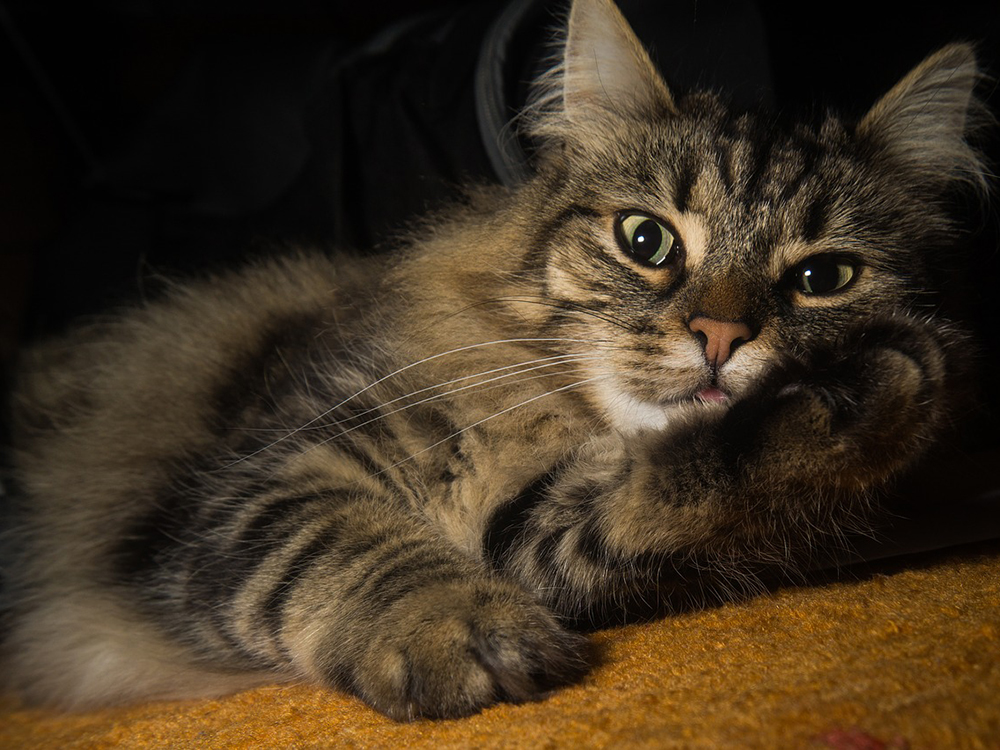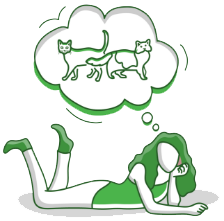
Norwegian Forest Cat Breed Pictures
Vital Breed Stats
| Weight: | 5 - 7 kg M | 5 - 7 kg F |
| Life Expectancy: | 12 - 15 years |
Breed Characteristics
| Size: |  |
| Grooming: |  |
| Good with Children: |  |
| Good with other pets: |  |
| Affectionate: |  |
| Active Level: |  |
Give a thumbs up if you love the Norwegian Forest Cat

0
More About the Breed
History
The Norwegian Forest cat, also called the ‘skogkatt’ (forest cat), is thought to have come from long-haired cats brought by Scandinavian Crusaders from Turkey. Some believe it may have evolved from short-haired cats from Great Britain. Whichever version may be true, it is a fact that the Wegie’s history goes back thousands of years. In Norse mythology, for example, goddess Freya’s chariot is said to have been drawn by giant cats. This feline also has its own legend, describing it as a ‘fairy cat’ that is able to climb rock faces that other cats would baulk at.
The Wegie managed to survive through its mousing skills, proving its existence valuable to sailors, farmers, and homemakers. Its present incarnation is said to be a product of interbreeding with feral and barn cats. However, this cat breed nearly died out during World War II due to cross-breeding with domestic cats. The Norwegian Forest Cat Club fortunately stepped in and supported the skogkatt’s survival for generations ahead.
Although the Norwegian Forest cat is Norway’s official cat according to King Olaf V, it only gained recognition as a breed in 1977 by Fédération Internationale Féline. Ten years later, the Cat Fanciers’ Association also officially recognised the breed. Today, the Wegie is very popular in Europe.
Appearance and Grooming
The Norwegian Forest cat, being a large, semi long-haired feline, strikingly looks like the Maine coon. This is no surprise as the Maine coon is said to be a descendant of Norway’s prized feline. However, they have considerable differences. The dominant one is the shape of their heads. The Maine coon’s head is wedge-shaped, whilst that of the Wegie is triangular, which is unlike other long-haired cat breeds. Its big almond eyes are set at an oblique angle, whilst its ears and paws are tufted, perfect for harsh Scandinavian winters.
The Wegie’s dense, glossy coat that envelopes a strong, durable body comes in various colours and patterns. However, the chocolate, fawn, lilac, Siamese, and cinnamon variety are not recognised by cat breed authorities though. Its double-layered coat serves as its built-in ‘winter attire,’ easily repelling water. Although its coat is so thick that it lends the breed an almost lion-like look, it does not require as much care as other breeds. A twice or thrice weekly combing will be enough. Its bushy tail has a distinct white tip. Its claws are remarkably strong, which gives the Norwegian Forest cat a superior climbing ability due to the excellent grip. It can even scale rocks, just as the legend said.
The Norwegian Forest cat’s size can be compared to that of small dogs, like pugs and Boston terriers. It can weigh from 7 to 16 pounds (even up to 22 pounds for males), and has an expectancy of about 12–16 years. Due to its massive size, it will take about 5 years for the Wegie to mature fully.
Temperament and Intelligence
The Wegie is known for being even-tempered, sweet, and gentle, which match its kind look. As their development into adulthood is slow, this cat keeps up its kitten-like ways longer than average. Intelligent, independent, and sociable, the Norwegian Forest cat likes human company, but is not demanding of attention. As such, it can entertain itself when alone. Owners with koi ponds and aquariums must be mindful of this cat’s hunting instincts as it will not hesitate to dive into a body of water to catch his next meal.
The skogkatt is also known for its ‘Scandinavian restraint’—reserved with visitors, will not take up lap space as much as other breeds, and expresses its needs in a quiet voice. However, it appreciates affectionate gestures, and returns them with a cheek rub or a nudge of its head.
The Wegie can thrive both outdoors and indoors. He does best with a family operating on a busy rhythm in the countryside. It also does well with children, dogs, and bigger pet birds. The Norwegian Forest cat also makes a great first cat for those who have not cared for a feline yet. Although it can be left on its own, it should not be solitary for a lengthy period.
Nutrition and Feeding
Health and Exercise
The Norwegian Forest cat is a playful breed and particularly enjoys interactive activities like ‘fetch.’ If kept indoors, it must be given spaces to hide and a high point to climb as it likes to observe things from an elevated place.
The Wegie is also known for its longevity and physical toughness, although predisposed to some genetic disorders, as follows:
- Polycystic kidney disease
- Glycogen storage disease type IV
- Hip dysplasia
- Hypertrophic cardiomyopathy (HCM)
Cost of Ownership
A pedigreed Norwegian Forest kitten may cost about £400–500. Insurance coverage may range from £15 to £25 a month in England. As with food costs, each month’s expense may reach up to £25. Veterinary care costs—vaccinations, boosters, annual checks—can reach no less than £600 in a year.
On average, a Wegie owner may spend about £40–£60 monthly depending on the insurance coverage. For its lifetime (16 years), costs can range from £7680 to £11,520, not including the initial cost of acquiring a Wegie kitten.
Is a Norwegian Forest Cat Right for You?
- The Norwegian Forest cat matures slowly, which means you will deal with a juvenile feline longer than average.
- The Wegie may have thick coats that does not need as much maintenance as other long-haired varieties, but it sheds abundantly periodically.
- This cat is a skilled hunter and thrives in the outdoors. As such, you may expect it to bring home a dead animal every now and then.
- The Norwegian Forest cat is a good feline for families and first-time cat owners.
- The Wegie is intelligent and requires challenging activities to occupy its time.
- Although sociable, the skogkatt is not clingy and tends to speak only when it needs something.









